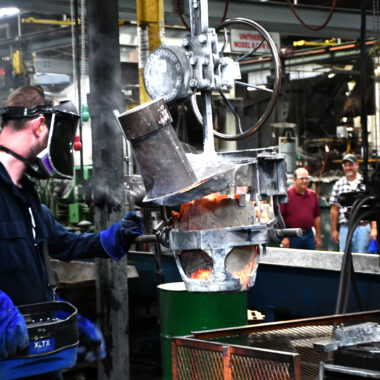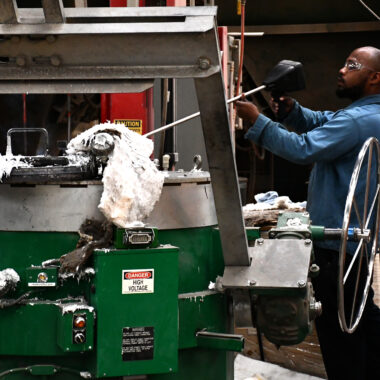Unraveling About Aluminum Casting: From Basics to Know-how
Unraveling About Aluminum Casting: From Basics to Know-how
Blog Article
Crafting Perfection: Exactly How to Achieve High-Quality Aluminum Castings Every Time
In the world of aluminum casting, the quest of excellence is a continual trip that requires a meticulous technique and an eager understanding of the intricacies included. Accomplishing regular high-grade aluminum castings demands a thorough understanding of the procedures, from choosing the appropriate alloy to implementing accurate mold and mildew styles and carefully managing casting criteria.
Understanding Light Weight Aluminum Casting Processes
Light weight aluminum casting procedures, necessary in the manufacturing sector, entail the complex change of molten aluminum right into solid types with a collection of thoroughly controlled steps. Understanding these procedures is extremely important to attaining high-grade light weight aluminum spreadings consistently - about aluminum casting. The key techniques utilized in aluminum casting are die casting, sand casting, and financial investment casting

Each of these processes has its benefits and is chosen based upon factors like intricacy, quantity, and preferred finish of the light weight aluminum casting. about aluminum casting. Understanding the intricacies of these methods is critical for producers intending to create high-grade light weight aluminum castings constantly
Selecting the Right Light Weight Aluminum Alloy
Picking the ideal aluminum alloy is an important choice in the production of top notch light weight aluminum castings. When picking an aluminum alloy for spreading, it is important to think about the specific demands of the application to guarantee optimal performance.
One of the most typically utilized light weight aluminum alloys for spreading is A356. This alloy offers superb castability, high toughness, and good deterioration resistance, making it appropriate for a wide variety of applications. Conversely, 6061 light weight aluminum alloy is favored for its superior weldability and good mechanical properties. For applications needing high strength, 7075 light weight aluminum alloy is a preferred selection due to its remarkable strength-to-weight ratio.
Along with mechanical residential properties, considerations such as expense, availability, and post-casting procedures should likewise affect the choice of the ideal light weight aluminum alloy. By meticulously examining these variables, makers can ensure the production of top notch aluminum castings that fulfill the desired requirements.
Implementing Correct Mold And Mildew Design
Establishing a reliable mold and mildew layout is vital for ensuring the effective production of high-quality light weight aluminum castings. Appropriate mold design plays a significant role in achieving the wanted attributes of the end product. To apply a successful mold and mildew style, elements such as product flow, cooling rates, and component geometry have to be carefully taken into consideration.
One trick element of mold style is guaranteeing appropriate filling and solidification of the light weight aluminum within the mold cavity. This entails creating runner and gating systems that help with smooth metal flow and protect against problems click here now such as air entrapment or incomplete dental filling. Furthermore, including cooling channels right into the mold and mildew style helps control solidification rates and lower the danger of porosity or shrinkage defects.

Controlling Casting Parameters

Making Certain Post-Casting High Quality Checks
To maintain the high top quality of light weight aluminum spreadings, complete post-casting quality checks are necessary. After the spreading procedure is completed, it is essential to make sure that the last products fulfill the preferred criteria and specifications.
Dimensional accuracy is an additional crucial element that has to be validated during post-casting high quality checks. Measurements of vital measurements and resistances ought to be taken to verify that the castings comply with the required specs. Furthermore, mechanical homes such as firmness, tensile strength, and influence resistance may need to be reviewed via material screening to make sure that the castings possess the required stamina click here for info and toughness for their designated application.
Final Thought
To conclude, achieving top quality light weight aluminum castings requires a comprehensive understanding of the casting procedures, selecting the appropriate alloy, creating molds efficiently, managing casting specifications thoroughly, and carrying out post-casting top quality checks carefully. By complying with these steps, producers can consistently generate aluminum castings that fulfill the greatest requirements of quality and efficiency.
Accomplishing consistent top notch light weight aluminum spreadings demands a detailed understanding of the processes, from picking the proper alloy to implementing specific mold and mildew styles and diligently regulating casting specifications. The key approaches made use of in light weight aluminum casting are die spreading, sand spreading, and financial investment spreading.
Financial investment spreading, likewise known as precision spreading, includes creating wax patterns that are coated in ceramic to create mold and mildews.Selecting the ideal aluminum alloy is a critical decision in the manufacturing of high-quality light weight aluminum spreadings.Ensuring accurate control over spreading criteria is necessary for keeping uniformity and high quality in aluminum casting production.
Report this page